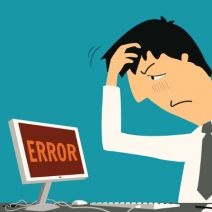 Knowing how to properly use your PC is key to its longevity. Therefore, you should never take for granted basic PC best practices. Here are three basic PC best practices that are easy to overlook.
Knowing how to properly use your PC is key to its longevity. Therefore, you should never take for granted basic PC best practices. Here are three basic PC best practices that are easy to overlook.
Don’t Plug Your Computer Equipment Directly Into an Outlet
While it’s likely that you plug a variety of your electronics directly into your outlet, you shouldn’t do this with computer equipment. The problem here is that electricity coming directly from outlets can fluctuate. For example, this is why your building’s lights may randomly get dimmer and then brighter. While your light bulbs can handle these power fluctuations, your computer equipment cannot; and it may lead to irreversible damages.
Instead, be sure to plug your equipment directly into a surge protector. This is a simple power strip that can be found at most any store. Though even a cheap power strip is better than no power strip, a basic power strip will not protect your PC as well as a heavy-duty one. Therefore, it’s worth it to drop some extra cash on a power strip that’s rated to protect your equipment from surges, instead of one that’s designed only to provide you with extra outlets.
For the best solution to these power surges, consider an Uninterrupted Power Supply (UPS). This is a device that both restricts surges in electricity, as well as provides additional power during a surge’s low point.
Don’t Click Next or Ok Without First Reading
Granted, it’s unreasonable to expect someone to read every word of every software agreement, but at the very least, you should skim it over to have an idea of what you’re agreeing to. It may be the case that a shady third-party software company is trying to pull a fast one on you. ComputerHope.com explains:
It is not uncommon for new users to click Ok or Next without reading what they are agreeing to and not making sure there are no check boxes still checked. Make sure you read every prompt before agreeing, or you may be agreeing to install new browser toolbars, a program you didn’t intend to install, or other crapware.
Don’t Open Unknown Email Attachments
A quality spam filter will go a long way to prevent a PC from getting slammed with a virus or malware. However, even the most secure system can be compromised if the user makes the mistake of downloading something that they shouldn’t, like a corrupted email attachment. Viruses that spread through email attachments are among the most common ways that computers become infected. In order to trick you to download the dangerous attachment, hackers will disguise the message as originating from a trustworthy source, like your bank, your hospital, a parcel delivery service, a resume, and much more.
As a rule, never download an email attachment unless you’re absolutely sure of the source, and if something seems sketchy, it probably is. Remember, if the email appears to come from a legitimate source, then you can always call the sender using the phone number that you have on record in order to confirm the message. If your source admits to not sending you the message, then you know it’s a scam.
By following these three best practices, you’re sure to save yourself the headache (and expense) of dealing with PC performance issues. Knowing how to properly use a PC is the best way to prevent issues and breakdowns. To learn more PC tips and best practices, subscribe to NuTech Services’s blog and give us a call at 810.230.9455.
